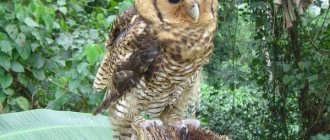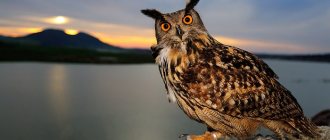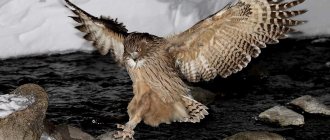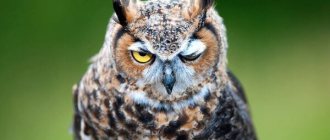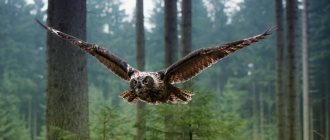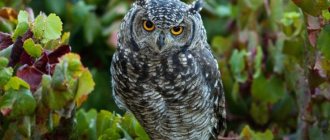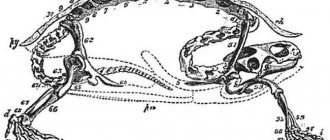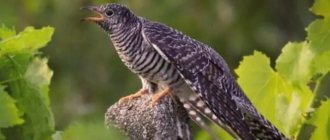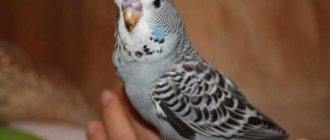Extreme circulatory adaptation
Owls vary greatly in size, appearance and color, but they all have one thing in common: the ability to turn their heads 270 degrees. To accomplish this task, their necks contain 14 vertebrae, instead of the usual seven that "normal" birds have. While the cervical vertebrae allow a certain range of motion, many animals, such as humans, would suffer severe arterial damage or complete circulatory interruption from such extreme movements.
In an attempt to understand how this is possible, scientists have discovered that owls have special blood storage systems that collect blood to feed the owl's brain and eyes when movement of the neck cuts off circulation. Another amazing adaptation of owls is that they have an alternative route for blood through their blood vessels, as well as covering the blood vessels with a sort of air cushion that prevents them from rupturing and causing strokes during sudden head movements.
Photo: The Chattanooga Times Free Press file phot
Reproduction and lifespan
Owls create permanent pairs and breed, as a rule, once a year. But the abundance of food can contribute to the creation of new clutches in the same season. its own nests in the forest ; it finds suitable hollows, occupies old nests abandoned by birds, and settles in crevices and secluded places. Some species, such as the short-eared owl, incubate their eggs on the ground, in areas of dense vegetation, or make small holes.
The clutch usually contains 3-10 white eggs - small in size, almost regular spherical in shape. The female incubates the eggs, starting with the first, for a month, so chicks of different ages appear in the nest later. The male takes part in feeding the female, and later, the emerging offspring.
The owlets hatch covered in down, but very weak, barely raising their heads. They are temporarily blind and deaf. When the last chick in the brood hatches, the eldest chick is already 10 days old. More attention goes to older chicks.
They are active in snatching food from the beaks of their parents; the younger ones may simply not get anything. In times of famine, cases of cannibalism occur, when adult birds attempt to kill their younger brothers in the nest.
After about 20 days, owl chicks The stay in the hollow is usually longer. In general, owlets become independent after 2-3 months.
Owls in nature rarely live longer than 8-10 years, since in their natural environment they have a high risk of becoming victims of larger predators - hawks and golden eagles. In captivity, the life of an owl is much longer, with centenarians reaching 40 years or more.
Crazy eyes
The vision of owls is quite peculiar. Their eyes are very large and set very close to each other. Owls' eyes are also completely motionless and cannot be considered true "eyeballs" since they are actually tubular. Binocular vision allows owls to focus completely on their prey, and improves their depth perception. However, it also makes owls more vulnerable to predators, which include other owls and flocks of angry songbirds. Owls can rotate their heads 270 degrees, which compensates for their frontal vision and fixed eyes.
Description and features
The diversity of the order of owls is represented by small birds from the size of a sparrow to large representatives 60-70 cm long. In various habitats, the color of the plumage is found in shades of gray-brown, brown, black and white.
But the general characteristics of owl-like birds make them recognizable in all corners of the planet - a round head with large eyes located in front, a short, curved beak. Ornithologists point out a number of anatomical features that distinguish owls from other birds of prey. For example, the structure of birds is different:
The paws on the feathered legs are strong and grasping. Powerful claws are adapted to capture and hold prey. The wide wingspan is 150-200 cm. The third and fourth feathers are the longest. The tail is short. In flight, owls reach speeds of up to 80 km/h.
The bird's head appears large due to its dense plumage, giving it a rounded shape. Birds are known to be able to rotate their heads 270° without any inconvenience or harm to health. This feature helps predators track prey.
Binocular vision provides clear black and white images. Having the lens in the corneal tube rather than the eyeball allows owls to see perfectly at night. The position of the eyes in front also contributes to successful hunting.
But a bird cannot roll its eyes like a human. Her gaze is always directed forward. The pupils are very sensitive not only to light fluctuations, but also dilate and contract during the predator’s breathing.
Birds hear four times better than cats. The outer ear is covered with a fold of skin and surrounded by radiant feathers. The slightest movement of the prey alerts the owl to its presence.
The bird's voice can be heard during the mating season; it is of a calling nature. In ancient times, it was associated with loneliness, sorrow, and was considered a demonic force. When a bird is irritated, it makes a characteristic clicking sound with its beak.
Listen to the voice of a short-eared owl
The color of owls is always camouflage and discreet. Black spots, specks, and stripes are scattered on the main gray-brown background. From a distance they blend into the surrounding background, and in the twilight the birds cannot be seen - the camouflage color is its advantage.
There are 2 families of owl-like birds - true owls and barn owls. Many genera of feathered predators inhabit territories from the equator to the northern countries. Some species of owls have become particularly famous.
Long-eared owl. Gray-brown plumage on the upper part of the body with dark spots, the lower part is marked with transverse lines. On the head there are ear tufts of feathers up to 3 cm, which give the bird its name.
The size of the owl is approximately 35 cm in length, with a wingspan of 90 cm. It prefers coniferous forests of European countries and northern Asia, where it nests. Hunts over open places - in fields, along copses. Leads a nocturnal lifestyle. It feeds on mice, small animals, and birds. The long-eared owl spends the winter months in Africa.
Listen to the voice of the long-eared owl
Gray owl. Large bird, body length up to 80 cm. Gray-smoky plumage color. The eyes are bright yellow. Taiga inhabitant. It is also found in the mountainous regions of Europe, in Mongolia. The owl got its name because of the black spot below its beak, similar to a beard. white feathers form a collar on its neck.
Sparrow owl. A small representative of the family, the bird’s body length is only 16-19 cm, weight 60-80 g. The head seems to be slightly flattened. There are rings of white and brown around the yellow eyes, and whitish eyebrows above the eyes.
Small yellowish specks strew the top of the owl's head; there are larger spots on the grey-brown feathers of the back. The abdomen is white with dark longitudinal stripes. The bird settles in spruce forests, hunts day and night, and leads a sedentary life.
Listen to the voice of the pygmy owl
Little owl. Light brown color range of plumage. The eyes are deep-set, as a result of which the bird has a frowning appearance. Round sand spots on the wings, oblong spots on the chest and abdomen.
The bird is common in Southern Altai, Transbaikalia, central Europe, Asian countries, and northern Africa. They prefer steppe areas, desert areas, where there are many rodents and lizards.
Listen to the little owl
Common barn owl. A striking difference of the bird is that the facial disc is heart-shaped. The peculiar appearance is complemented by the asymmetrical arrangement of the ears - the left ear is located along the line of the forehead, and the right one should be looked for in the area of the nostrils. This feature provides the bird with good hearing.
The size of the barn owl is average - body length up to 39 cm, weight 200-500 g. The plumage on the back is bright red, with numerous spots, specks, and stripes. The shades change according to the bird's habitat.
Listen to the voice of a barn owl
White Owl. The bird is an inhabitant of the tundra, so camouflage color is very important for snowy areas. The dark beak, black spots, yellow eyes seem especially bright in the snow-white plumage.
The bird is up to 65 cm long and weighs up to 2.5 kg. They prefer open areas and almost never fly into forest areas. The diet is based on lemmings. The polar owl is listed in the Red Book; a rare species lives in Greenland and North America.
Hawk owl. The size of the bird can be compared to the size of a crow. A remarkable striped color is characteristic of the lower part of the body. The main tone is brown-brown with white spots.
Found in Karelia, Murmansk region, Kamchatka, Asia, North America. The tail is long. The hawk owl is a wintering bird. In the diet of harsh times, hazel grouse and white partridges appear instead of rodents.
Listen to the hawk owl
Scops Owl (common scops owl). The plumage is gray-brown in color with multiple streaks and light transverse stripes. The length of the scops owl is approximately 22 cm, weight 80 g. It lives in mountain forest areas. Migrant. Winters in Africa and southern Asia.
Listen to the voice of Scops Owl
Owl. In the large family of owls, this is the largest representative. On the large head, in the areas of the auditory openings, there are hard feathers similar to auricles. The color of the feathers is fawn, ocher.
Unlike many of their relatives, they hunt large prey during the day - hares, young roe deer, pheasants. Favorite habitats are steppes, where the large wingspan meets no obstacles.
Listen to the voice of an owl
Some owls eat plants
Owls are among the most carnivorous birds in the world. Making up only a fraction of the total bird kingdom in the world, these nocturnal hunters in most cases do not disdain carrion. However, one species of these night conquerors is quite unique. In a completely unique case for this group of birds, the elf owl feeds not only on small animals, but also adds seeds and fruits to its diet. These owls also engage in a form of "breeding": they scatter droppings around their nests in hopes of attracting dung beetles. These adventurous predators also enjoy the berries of the Indian prickly pear and the fruits of the Cylindropuntia leptocaulis cactus, which form the plant part of their diet.
Many owls do not hoot or screech.
Stereotypically, owls hoot, but in fact, several species of owls do not hoot at all. Snowy owls, found in the very north, make creaking sounds similar to those made by seabirds, and not at all similar to the usual owl hooting.
Photo: www.oceanwide-expeditions.com
Small owls, such as pygmy owls, make boring whistling sounds. The most outrageous example is the North American armyworm. It makes no squealing or squeaking sounds at all, but instead produces an impressive series of fast and whistling beeps. But the unearthly creaking sounds made by great eagle owl chicks often lead to false reports that someone has heard the calls of the North American owl.
Lifestyle and habitat
Owls are distributed everywhere - they can be found on the seashore, in the desert, in mountainous areas, among steppes, and forests. The only place you can't find owls is in Antarctica. Russia is home to 18 species of owl birds. In addition to wild nature, predators stay in the suburbs, not far from human habitation.
In the attics of buildings, under the roofs of houses, you can find that an owl lives there. What kind of bird, migratory or not , becomes clear from its behavior with the arrival of cold weather. Not all species of owls fly to the southern regions; most are sedentary. Migrations are caused only by an acute shortage of food. Mountain birds migrate to the plains, northern owls leave their nesting sites before the weather warms up.
Wooded areas attract birds more, but there are species associated with open areas. Bird nests can be found in abandoned hollows, among rock crevices; polar owls lay eggs simply in a hole.
The owl is a nocturnal bird , but white hawks, hawks, and little owls also hunt during the daytime. Excellent eyesight, keen hearing, and the ability to fly silently make birds unrivaled hunters. In search of prey, they sometimes emit sharp screams that scare away rodents. The slightest movement serves as a signal to the predator to attack.
You can determine the type of bird by its voice and characteristic sounds:
Owls lead a solitary lifestyle and do not form flocks. Isolated existence is associated with attachment to a specific area, individual territory.
They hunt bigger prey than you might think
Eagle owls are among the largest winged predators on the planet and combine enormous size with incredible ferocity. They hunt almost anything and stop at nothing. Pallid eagle owls can easily carry vervet monkeys in their talons, and African warthog babies can also be desirable prey for them. They even hunt owls, about their own size, that feed on fish. Eurasian eagle owls are just as ferocious as their African relatives. There were cases when they killed the usually invulnerable golden eagles.
According to an eyewitness, a Eurasian eagle owl attacked a young wolf, but small deer and foxes are common prey. In one stunning attack, a great eagle owl killed a huge, snake-eating secretary bird. Eagle owls also attack herons, but the strangest thing is their predilection for the meat of hedgehogs, which, when possible, consists of a large part of their diet. While most animal species are repelled by hedgehogs' mass of quills, this owl uses its massive, scaly talons to rip the quills off a hedgehog like the skin of a fruit, a task that, although not an easy one, is well within its capabilities.
Nutrition
The owl is a bird of prey whose diet is based on food of animal origin. Being excellent hunters, birds provide themselves with provisions in any conditions. The food supply depends on the habitat.
Small birds eat a huge number of amphibians, various insects (beetles, grasshoppers), small rodents (mice, voles), which bring great benefits by destroying harmful forest inhabitants.
Large owls hunt mammals (hedgehogs, hares). They also eat rats, lizards, snakes, lemmings, frogs, and shrews. Owls attack birds less often, but in times of famine they attack chickens and small passerines. Species of owls living on the coastal strip fish and eat crabs and mussels.
It is a known feature of owls to go without water for a long time, up to a month. When absolutely necessary, they replenish the need for drinking with the blood of victims. But birds of prey need water bodies not only to quench their thirst, but also for hygiene procedures. In tropical countries, owls supplement their diet with healthy fruits, berries, and plants.
They live in cacti
In the North American Sonoran Desert, carnegias can grow up to 10 meters in height and form an entire forest. The holes dug into these cacti by the golden woodpeckers, specially adapted for this work, are used for nesting by elf owls, who peer out from the cacti with their bright yellow eyes.
Photo: Shutterstock
Another species of small owl called the tawny owl also lives in the cactus forests. This much more aggressive bird-eating owl is slightly larger in size. It also nests in Carnegias and Stenocereus. Continuing the topic, it is worth noting that the huge Great Eagle Owl often nests on the branches of such cacti.
Owls are silent killers
Owls are such effective predators in large part due to their incredibly well-developed hearing, which they use in complete silence. However, this method of determining the location of prey requires some rather interesting adaptations. Special hooks on the outer feathers of an owl's wing act as airflow mufflers, while the "fluff" on their trailing edge provides silent flight, allowing the owl to suddenly attack an unsuspecting prey from behind.
In order to reach the pinnacle of auditory perception, owls spit on generally accepted concepts of animal symmetry. In several species of owls, the ears are located asymmetrically and are located at different levels of the bird's head. This allows owls to locate the source of a sound in multiple dimensions, which helps them position themselves in the best position to attack.
Owl pseudocannibalism
The term "cannibalism" technically refers to the act of predatory behavior towards a member of its own species. And the fact that owls are actually not averse to eating owls of different species may come as a shock to a new bird watcher. Great eagle owls are actually the top predators of the smaller spotted owls. Spotted owls, in turn, hunt even smaller owls.
The expansion of the spotted owl's range from the southeastern swamps to the Pacific Northwest is believed to be due in part to population declines of the Western Short-eared Owl as a result of owl-on-owl hunting. In addition to other owls, there are several species of birds that actively prey on lesser long-eared owls. Luckily, you can help: If you're one of those people who like to listen to recordings of bird songs loudly to try to lure birds away, stop. These sounds can cause owls to respond and give away their location to predators.
Photo: Nick Jewell/Flickr/CC by 2.0
Keeping at home
You can have an owl as a pet if you are willing to provide the bird with its vital needs. A night hunter will want activity from evening to morning, so the bird will not let its owner sleep.
To feed, owls need whole carcasses of rodents or birds; meat just won’t do. Not every owner will be internally prepared for this. Birds need enough space to not sit in a cage, spread their wings, and sometimes fly. Eagle owls, tawny owls and other large birds are not suitable for keeping in an apartment.
The owl in the photo always attracts attention with its attentive gaze. Owners of tame birds note their intelligence, playfulness, vitality, and curiosity. You should only buy an owlet from a nursery, since the markets often sell individuals caught by poachers.
Wild birds are often unhealthy, so you can bring the infection into the house and be left without a pet. Diseases in birds develop rapidly. Only a competent approach and sincere care will ensure the health and well-being of the owlet.
Source
Strange relatives
Owls are often called birds of prey, but these nocturnal hunters are not related to hawks, eagles or falcons, which are diurnal birds of prey. Taxonomy is a controversial and changing science, however, according to the Sibley-Alquist classification of birds and alternative methods of determining the ancestry of owls, they are related to kingfishers, hummingbirds and even song passerines (such as swallows), but not to hawks. Hawks and other diurnal birds of prey belong to the more primitive branches of the bird lineage, and are related to cranes, herons and other birds that look a little prehistoric.
Although their appearance is similar to that of a hawk, owls are very closely related to the humble true nightjar. The similarities in appearance between owls and diurnal birds of prey are quite obvious, especially when the owl fluffs up its feathers and opens its large hawk-like beak. However, the reason for this similarity is convergent evolution, not kinship. Birds of prey that are diurnal and nocturnal occupy similar ecological niches, but avoid competition by hunting at different hours with their competitors.
How do owls “look” with their ears?
About 8,300 species of birds live on our planet. The majority of them lead a diurnal lifestyle. This is not surprising, since flying in daylight is not only safer, but also easier. In addition, it is also much easier to find food during the daytime.
That is why vision in birds is extremely well developed (the eyes and the corresponding brain centers). This is where the legends about the extraordinary vigilance of eagles and their fast-winged relatives originate.
Consequently, the majority of birds wake up at sunrise and go to rest at sunset, which can be easily seen if you listen to the morning and night forest. However, among the birds there are also such originals who, on the contrary, sleep during the daytime, preferring to perform all the most important functions at night. In the dark, they not only fly, but also build nests, hatch chicks, hunt, indulge in mating games, in a word, do everything that others do in the light. And, I must say, they do it no worse. The most interesting among such feathered night owls are owls, whose image with huge eyes, like searchlights, is known to anyone who has at least some idea about the world of birds.
The owl is a typical nocturnal predator.
Culture of communication between people and owls
Everyone is familiar and understands the stereotype of the “wise owl,” but in fact, in some cultures they are viewed as demonic symbols and harbingers of doom. They are also often associated with witchcraft. The popularity of owls in modern pop culture has also grown thanks to famous owls such as Hedwig, the snowy owl who starred in the Harry Potter film series.
Besides their cultural significance, owls are also used by humans for sport falconry. Hunter's owls are tamed to the glove and trained to chase various game, such as a hare. As a rule, owls are birds similar in character to cats - they are nocturnal and difficult to learn. While some large owls are used as hunting companions in Europe, their use as falcon bait is more common. Hawks constantly attack and hate owls, so an owl tied to a perch makes excellent bait when catching a hawk or falcon.
Owl bird. Description, features, types, lifestyle and habitat of the owl
Since ancient times, humans have developed a special relationship with owls, the oldest inhabitants of the planet. An intelligent, deep creature of the wild, endowed with mystery and special magic by man. The owl is a bird that has entered the culture of peoples, becoming a symbol of wisdom, a messenger of magical powers. In ordinary life, the winged predator is no less interesting than in books.
Did you know?
- Owls make almost no noise while flying. Even when tested indoors with multiple microphones, it was not possible to record the sound of the wings moving.
- Owls and crows literally hate each other. They instinctively attack each other, even if they have not met before.
- Many wineries use barn owls for rodent control.
- The color of an owl's eyes indicates what time of day they prefer to be active.
- Some owls keep blind snakes in their nests as beneficial partners, thereby reducing the abundance of nest parasites.
- The Elf Owl is the lightest owl on our planet. It weighs just over 28 cm.
- Owls are weighed by taking them out of their nests and wrapping them in blankets. It turns out something like a small bird burrito.
- Hedwig was played by four different snowy owls in the Harry Potter films.
- Barn owls have a higher left ear than their right ear, so they can detect prey on horizontal and vertical surfaces.
- There is a giant owl whose weight exceeds 9 kg and height is about 92 cm.
- There is a species of owl that lives in earthen burrows.
- The northern white-faced owl has a unique innate fight-or-flight response. It is this that makes it appear larger when confronted with a larger individual and smaller when confronted with a larger opponent.
- According to Pliny the Elder (23 – 79), owl eggs were commonly used as a hangover cure. In ancient times, owls were also associated with misfortune and evil omens. In the modern world they are associated with wisdom.
- A group of owls is called a parliament.
